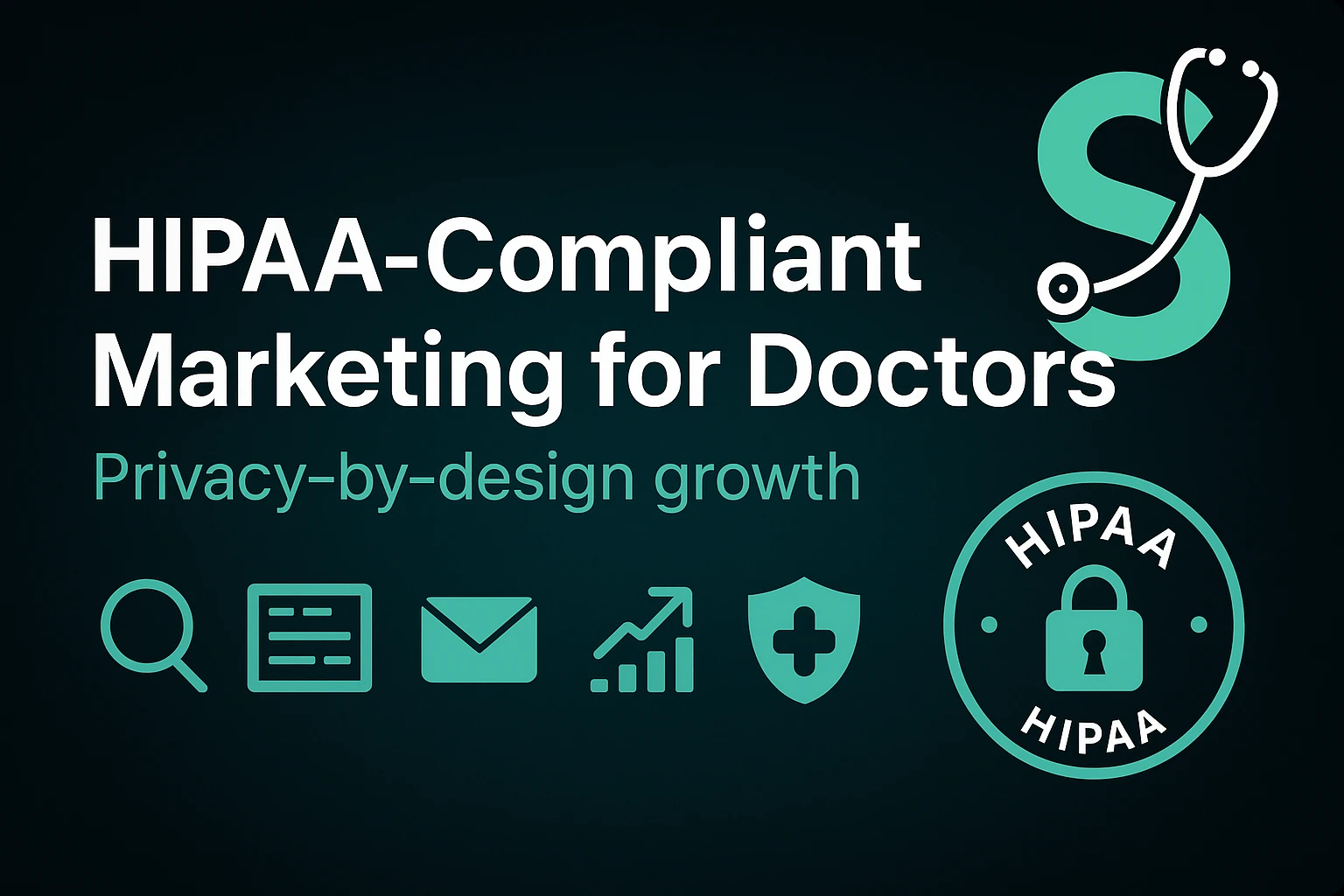HIPAA Compliant Marketing Solutions for Doctors in 2025
HIPAA Compliant Marketing Solutions for Doctors must balance growth with uncompromising privacy. HIPAA sets the rules; recent guidance and enforcement (federal, state, and FTC) sharpen the edges. Social pixels, granular remarketing, and third-party data sharing are now high-risk or off-limits when PHI is involved.
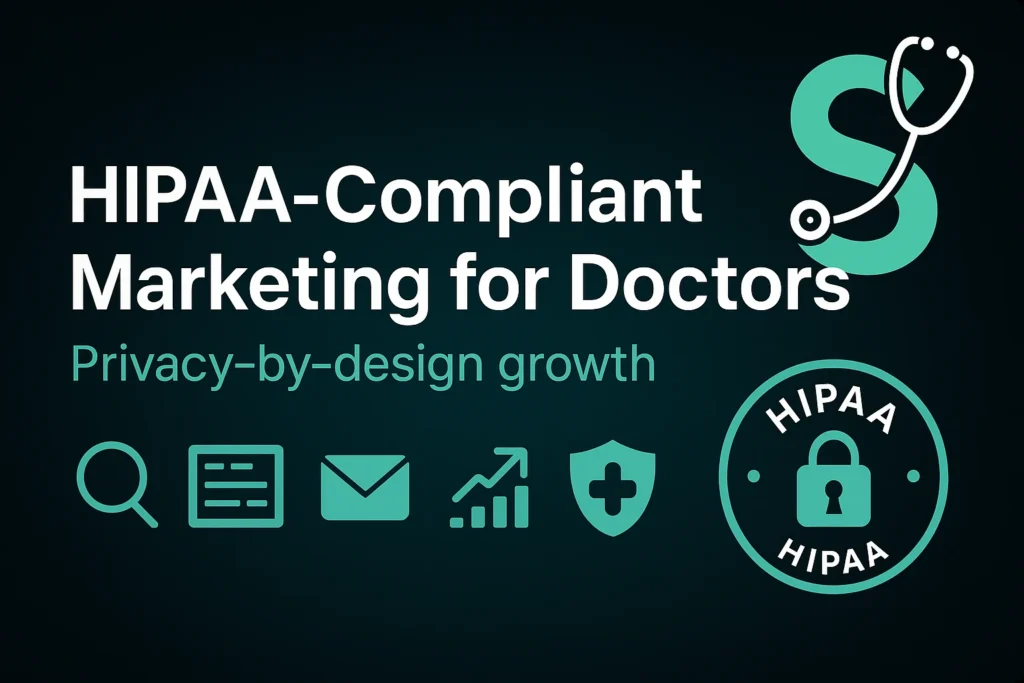
This guide lays out a privacy-by-design playbook—search and contextual ads, first-party consent programs, HIPAA-compliant email, privacy-centric analytics/CDPs, de-identified insights, and strict tag governance—and explains recent regulations (including on social platforms), new limits on remarketing, and how to grow without exposing PHI.
Table of Contents
Regulations, Challenges, and Strategies
Marketing in the healthcare sector must be handled with extreme care due to strict privacy laws.
In the United States, the Health Insurance Portability and Accountability Act (HIPAA) sets high standards for protecting patient information, which creates unique challenges for doctors and medical practices looking to advertise their services. In recent years, regulators have issued new guidance and rulings that directly impact how healthcare providers can use digital marketing, especially on social media and through retargeting campaigns.
High-profile enforcement actions – including fines and lawsuits – underscore the risks of non-compliance, making it more important than ever for doctors to find HIPAA-compliant marketing solutions.
Quick Read: HIPAA training for mental health professionals
What HIPAA Means for Healthcare Marketing
Under HIPAA’s Privacy Rule, protected health information (PHI) includes any individually identifiable health information. That definition extends beyond medical records to personal identifiers (like names or emails) and even technical signals (like IP addresses or page URLs) when the surrounding context links a person to seeking or receiving care. In practice, PHI includes data that reveals health status or care intent; a patient who visits a page about a condition creates a data trail that can identify them in a healthcare context.
HIPAA treats most promotional communications as marketing. If a message encourages the purchase or use of a product or service, it is marketing and requires the patient’s explicit, written authorization when PHI is used. Limited exceptions apply to treatment, care coordination, or operations—appointment reminders, refill notices, or care instructions—but those uses cannot spill PHI into advertising ecosystems. The rule is simple: marketing that uses PHI needs authorization; operations that use PHI must stay within covered workflows and systems.

For marketers, the boundary is clear. Using patient information outside treatment or operations—such as targeting ads with visit history or form data—requires a HIPAA-compliant authorization that specifies purpose and scope and preserves the right to revoke.
Because that threshold is high, most practices avoid identifiable patient data in advertising altogether and rely on privacy-by-design tactics instead.
Digital identifiers in context
Seemingly innocuous data—cookies, device IDs, IP addresses, page paths, query strings—can become PHI when the context ties the signal to healthcare. A person who loads “/oncology/chemotherapy-options” is, by definition, associated with oncology services; the URL combined with device metadata identifies health interest. When that telemetry flows to a third party, a disclosure can occur.
This is why tracking and analytics in healthcare must be handled like clinical data. Any tool that collects user behavior on a medical site can inadvertently process PHI and trigger HIPAA obligations. Safe practice means minimizing identifiers on public pages, blocking trackers on portals and forms, keeping PHI inside BAA-covered platforms, and never transmitting PHI—hashed or otherwise—to advertising networks that will not sign a BAA. The operating principle is consistent: context creates PHI, and governance prevents leakage.
Recent Regulatory Guidance and Rulings (2022–2025)
In December 2022, HHS/OCR issued tracking guidance that reshaped HIPAA-compliant marketing. The guidance warned that cookies, analytics, and social pixels can create unauthorized PHI disclosures when technical signals tie a user to a covered entity. Principle: technical data plus healthcare context constitutes PHI. Outcome: data flows to third parties require a HIPAA authorization or a BAA—often unavailable with ad platforms.
Organizations reacted in 2023 with audits, pixel removals, and breach notifications. OCR and the FTC followed with joint warning letters to hospital systems and digital health providers, signaling that Meta Pixel, Google Analytics, and similar tools could unlawfully transmit PHI. Rule: platforms that won’t sign a BAA cannot receive PHI. Result: social pixels and granular remarketing became high-risk for hipaa compliant marketing solutions for medical practices.
The FTC intensified enforcement using consumer protection law. GoodRx paid $1.5M for deceptive sharing of medication and health data; BetterHelp paid $7.8M and accepted a ban on using health data for ads. Fact: privacy promises create legal obligations. Implication: retargeting based on health interest without valid consent violates those promises.

States and courts added pressure. New York’s Attorney General fined NewYork-Presbyterian for tracker misuse and mandated corrective actions. Class actions against health systems alleged that pixels inside portals and scheduling flows sent appointment and condition data to social platforms. Reality: a pixel on a sensitive path becomes a disclosure; a disclosure without authorization becomes liability.
Industry pushback arrived in late 2023. The AHA challenged the breadth of the tracking bulletin. In June 2024, a federal court narrowed parts of the guidance for unauthenticated
pages, holding that an IP address plus a visit to a public page is not automatically PHI. Narrow holding: unauthenticated context alone may not equal PHI. Unchanged core: tracking on authenticated pages (portals, forms) still transmits PHI and remains off-limits.
Bottom line for healthcare marketing: enforcement tightened from 2022 to 2025; platforms disclaimed HIPAA environments; plaintiffs tested pixel theories. Strategy shift: minimize identifiers, contain PHI within BAA-covered tools, and favor identity-free tactics (search, contextual, consented first-party programs) to stay compliant while you grow.
HIPAA Compliant Tracking Technologies for Social Media Under Scrutiny
Regulators now treat social platforms and trackers as high-risk in healthcare. Facebook (Meta), Google, TikTok, LinkedIn or Bing do not operate HIPAA-compliant advertising environments and do not sign Business Associate Agreements (BAAs). If a clinic deploys a social pixel or uploads contact data for ads, the platform does not assume HIPAA obligations—and most terms forbid sending health data at all.
Why pixels on health pages create PHI risk
Tracking pixels and cookies collect user interactions and transmit them to third parties. In healthcare, a pixel firing on “/oncology/” or “Schedule an HIV test” links a person to care and creates PHI. Investigations have shown page titles, URLs, and IP addresses tying individuals to conditions and disclosing PHI to ad platforms. HHS’s guidance makes it plain: tracking on authenticated pages (portals, forms, scheduling) transmits PHI and violates HIPAA.

Consent banners aren’t enough
Cookie banners that ask for “marketing cookies” do not equal HIPAA authorization. HIPAA authorization requires specific, written consent with revocation rights. Because simple opt-in banners fall short, many providers remove pixels entirely from sensitive paths or block them with strict tag rules.
“Healthcare filters” don’t solve HIPAA
Meta’s filtered pixel for healthcare still disclaims HIPAA compliance and places responsibility on the provider to ensure no PHI is sent. In practice, even a URL or device ID can become PHI in context; guaranteeing zero PHI is not feasible.
No BAAs with ad platforms = no PHI sharing
Major ad platforms won’t sign BAAs for advertising use. Google’s policies prohibit using GA4 or Google Ads to track or target sensitive health data; GA4 is not HIPAA-compliant. Common tactics like “custom audiences” (uploading emails/phones, even hashed) constitute PHI disclosures. Without a BAA and proper authorization, those uploads are unlawful for covered entities.
Learn How To Do HIPAA Compliant Healthcare Social Media Marketing in 2025
Practical takeaway
For HIPAA-compliant marketing solutions for medical practices, assume mainstream social/ad networks cannot receive PHI under any circumstance. Keep PHI inside BAA-covered systems; keep outreach identity-free on public ad platforms (e.g., search/contextual) and never let pixels fire on portals, forms, or condition pages.
Why Remarketing Is Now Greatly Limited
Social Media Remarketing relies on identifying a person, tracking their behavior, and tailoring ads from that history. In healthcare, that chain creates PHI: a user visits a condition page → the visit links identity to health interest → the ad uses that linkage. Under HIPAA, using PHI for marketing without explicit authorization is not permitted, and transmitting those signals to ad networks compounds the violation.
Where pixels must not fire
Patient portals, login pages, online scheduling, intake forms, and symptom checkers inherently process PHI. Tracking on these paths discloses PHI to third parties and breaks HIPAA. Even public condition pages can create PHI when a URL and device signal identify a person’s health interest in context.
Make sure your website design is propperly optimized and that you’re tracking in the correct places.
HIPAA Compliant retargeting is still possible
Retargeting is only plausible in HIPAA-safe form and even then is narrow. The workable model is identity-free: broad, non-diagnostic segments; no PHI; no uploads to platforms that won’t sign a BAA; and no signals from sensitive paths. If you cannot guarantee those constraints, you cannot retarget.
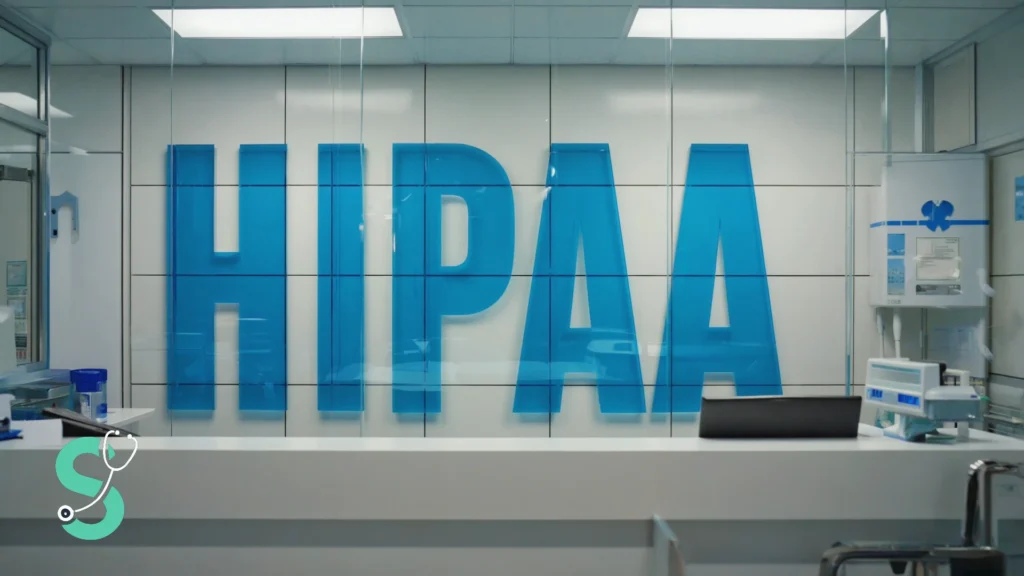
Guardrails that are mandatory
- Scope control: Place tags only on generic pages (e.g., homepage, contact). A tag on “/orthopedics/knee-replacement” creates health inference risk.
- Audience breadth: Build large, non-granular pools (e.g., “any page in last 30 days”), not micro-segments tied to conditions.
- Zero identifiers: Do not collect or transmit emails, phone numbers, user IDs, form fields, query strings, or full URLs that reveal health topics. Do not upload lists (“custom audiences”) unless you have valid HIPAA authorization and a signed BAA with the vendor—which ad platforms generally won’t provide.
- Tag governance: Use a strict tag manager to auto-block marketing scripts on any page that can involve PHI (portals, forms, keywords like “patient,” “appointment,” “results”).
- Consent realism: Cookie banners are not HIPAA authorization. Even with opt-in, you still must prevent PHI from leaving your environment.
The trade-off you should expect
Privacy-preserving remarketing is, by design, less granular. Broader segments reduce targeting precision; CTR and CVR may fall versus classic retargeting. The compliance equation is non-negotiable: patient trust > ad efficiency. Practices that keep PHI inside BAA-covered systems and keep media buys identity-free stay on the right side of HIPAA while still maintaining brand presence.
Strategies for HIPAA-Compliant Marketing
The rule of thumb: don’t use individually identifiable health information without permission. Favor contextual, aggregate, or permission-based tactics.
1) Search Engine Advertising (PPC)
Pay per Click Campaigns continue to be the most secure way to advertise for doctors, capturing search intent and getting calls right away.
Target keyword intent, not identity (e.g., “pediatrician in Chicago”).
How: Cluster campaigns by symptoms, services, insurance, and neighborhoods; optimize for calls/form starts/appointments.
Benefits: High intent → faster patient acquisition, predictable CAC, no PHI handling.
Impact: Shortens time-to-appointment; scalable budget with clear ROAS.
2) Contextual Display & Programmatic
Match ads to page content, not user history (e.g., cardiology near heart-health articles).
How: Use topic/URL/category targeting; disable behavioral retargeting and lookalikes from health behavior.
Benefits: Brand reach without risk, strong relevance signals, privacy-by-design compliance.
Impact: Cost-efficient awareness that safely fills the top of funnel.
Quick Read: Programmatic Display Ads for Medical Businesses
3) First-Party Data with Explicit Consent
Grow permission-based email/SMS via clear opt-ins (newsletters, events, downloads).
How: Use vendors that sign BAAs; encrypt; segment by declared interests (not diagnoses); honor opt-outs.
Benefits: Owned audience, higher engagement, compliant lifecycle nurturing.
Impact: Better retention/reactivation; lower dependence on paid media.

4) Content Marketing & SEO
In this day and age, Search Engine Optimization for Healthcare Clinics is a must to save on Ad spent and get organic visibility in the major search engines like Google and Bing.
Educate to create demand—guides, service pages, videos, physician bios—no personal data required.
How: Local SEO (GMB, NAP, reviews), E-E-A-T (authorship, citations), schema where appropriate; keep third-party trackers off portals/forms.
Benefits: Compounding traffic, authority, trust; 24/7 patient discovery.
Impact: Lower long-term CAC; more qualified inbound leads.
Read this article to know more: SEO for Doctors: Full Guide to Get Massive Results in 2025
5) Lead with Privacy in Your Message
Make privacy a promise and a control: “No tracking pixels on patient pages,” “We never share your data.”
How: Mirror claims with tech controls (tag blocks, vendor BAAs, PHI suppression).
Benefits: Differentiation, higher conversion from privacy-conscious patients, reduced complaint risk.
Impact: Higher landing-page CVR and review sentiment.
Explore how to generate more leads for your healthcare business here.
6) HIPAA-Capable Analytics & CDPs
Measure only what you can govern.
How: Choose tools with BAAs, PHI suppression, RBAC, and audit logs; strip identifiers; avoid full URLs with query strings.
Benefits: Insight without exposure; audit-ready reporting for compliance.
Impact: Fewer incidents; faster approvals from legal/compliance teams.

Explore: 25 Best Ads for Miami Doctors in 2025
7) Aggregated & De-Identified Insights
Plan media with cohorts/geographies, not people.
How: Use ZIP-level trends and service-line volumes for OOH, CTV, sponsorships; confirm de-identification (18 identifiers removed or expert determination).
Benefits: Smarter spend allocation without PHI; minimal re-identification risk.
Impact: Stronger reach where demand exists; cleaner compliance posture.
8) Patient Authorizations for Specific Campaigns
When targeting is necessary, obtain written HIPAA authorization (purpose, scope, expiration, revocation).
How: Offer at intake for well-described programs; store securely; automate revocation handling.
Benefits: Lawful personalization; higher relevance for patients who opt in.
Impact: Better campaign efficiency for narrow service lines.
Explore: Guide to Online Appointment Scheduling for Doctors in 2025
9) Traditional & Community Channels
Use one-to-many channels with zero PHI: local radio, print, direct mail, community talks, health fairs, organic social.
How: Train staff never to confirm patient status in comments; get written consent for testimonials/photos.
Benefits: Safe brand lift; local trust; referral growth.
Impact: Strong awareness and physician-to-physician/community referrals.
This is How your clinic should do HIPAA Compliant Email Campaigns
10) Operational Guardrails (Everywhere)
Enforce tag governance so marketing scripts never fire on portals, forms, scheduling, or condition pages.
How: Data minimization by default; BAA-signed vendors; change logs; quarterly audits; staff training.
Benefits: Prevents leaks before they happen; speeds compliance sign-off.
Impact: Lower legal risk; fewer engineering reworks; stable campaign uptime.
Bottom line: Keep PHI inside governed, BAA-covered systems; keep paid media identity-free; and grow through consent, context, and content. You get safer acquisition, stronger trust, and durable ROI—without ever compromising HIPAA.airs, and organic social posts (no identifiers).
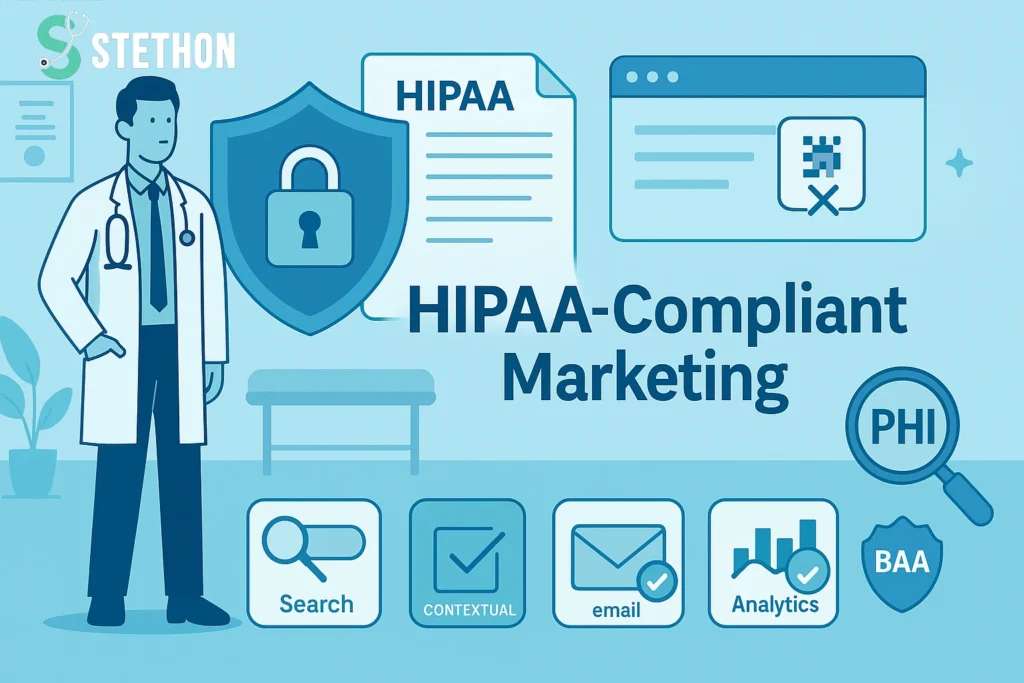
Building HIPAA-Compliant Marketing Solutions for Doctors That Scale
Healthcare paid media is being rewired as privacy regulation meets digital advertising reality. The signal from HHS/OCR guidance + FTC actions + state AG settlements is unmistakable: patient privacy is paramount.
Translation for marketers: Meta/GA pixels + granular remarketing + third-party data sharing are high-risk whenever PHI could be implicated.
Risk → fines, lawsuits, reputational harm; Trust → retention, better care conversations.
What changes:
- HIPAA → restricts PHI for marketing without explicit authorization.
- HHS/OCR → interprets tracking on healthcare properties as PHI-touching in many contexts.
- Courts → narrowed parts of the 2022 tracker bulletin, but did not greenlight PHI leakage; authenticated areas remain off-limits.
- FTC/AGs → enforce promises and punish deceptive sharing of health data, even beyond classic covered entities.
What works:
- Search & contextual ads → intent and content, not identity.
- First-party programs with consent → HIPAA-capable email/SMS under BAAs.
- Privacy-centric analytics/CDPs → PHI suppression, access control, auditability.
- De-identified/aggregated insights → planning without personal data.
- Clear tag governance → block trackers on portals, forms, and condition pages.
Read this article to know How to Increase Patient Volume in a Medical Office
The upside: Privacy constraints force better marketing—useful content, transparent messaging, and channel mixes that respect users and regulators. Practices that lead with privacy-by-design strengthen brand trust, reduce legal exposure, and still grow.
Bottom line: HIPAA-compliant marketing is absolutely achievable with the right mix of caution, strategy, and tooling. Stay current on rulings, document your controls, train your team, and build campaigns that center patient rights. In a privacy-first era, trust is the competitive edge.
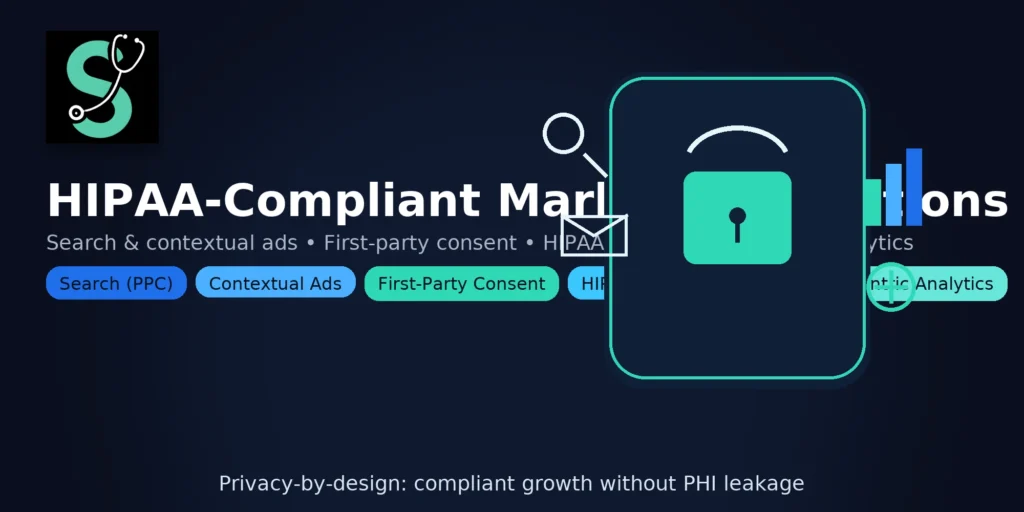
HIPAA Digital Marketing For Medical Businesses FAQ
What recent changes matter most for doctors’ marketing?
HHS/OCR’s 2022 tracking guidance treated many web trackers as handling PHI; enforcement ramped up in 2023–2024. A 2024 court narrowed the rule for public pages, but tracking on authenticated areas (portals, forms, scheduling) is still off-limits—and regulators continue to prioritize digital privacy.
What HIPAA fines or cases should I know about?
GoodRx paid $1.5M (FTC) for sharing health data with ad partners; BetterHelp paid $7.8M and was banned from using health data for ads. NewYork-Presbyterian paid $300k over advertising trackers, and multiple health systems faced multi-million-patient pixel lawsuits/settlements.
Is remarketing (retargeting) still allowed?
Only in very limited, identity-free forms. No pixels on portals or condition pages, no custom-audience uploads of patient lists, and no transmission of identifiers or health-revealing URLs. Broad, non-diagnostic site visitor pools are the upper bound—and many practices skip retargeting entirely.
Are social pixels and GA4 acceptable if I show a cookie banner?
No. Cookie consent ≠ HIPAA authorization. Major ad platforms won’t sign BAAs, GA4 isn’t HIPAA-compliant, and pixels can leak PHI via URLs, IPs, or form data—even if “filtered.”
What channels are safest and still perform?
Search ads (keyword intent), contextual ads (page content, not identity), first-party email/SMS with explicit consent on BAA-backed platforms, privacy-centric analytics/CDPs, and content + SEO. These respect HIPAA while driving steady, defensible growth.
